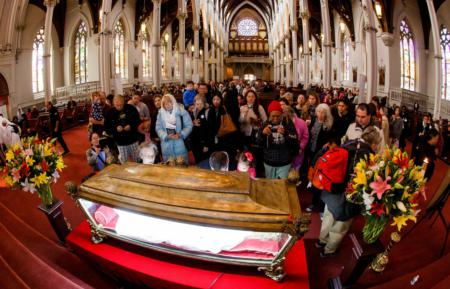Maria Goretti's remains
Q. I understand that the church does not want me to keep the cremated remains of my saintly (in my opinion) great-aunt on a shelf in my family room and that I should consign them instead to a grave or mausoleum niche. Why, then, are the skeletal remains of an acknowledged saint (in this case, Maria Goretti) being toted from diocese to diocese? (I'm sure that she was far more saintly than my great-aunt, but the failure to inter or entomb her reverently puzzles me.) (Columbus, Ohio)
A. The church's guidelines on cremated remains are grounded in the Catholic belief in the resurrection of the dead and the dignity of the human body as created by God. Accordingly, the appendix to the Order of Christian Funerals (No. 417) provides that "the cremated remains should be buried in a grave or entombed in a mausoleum. ... The practice of scattering cremated remains on the sea, from the air or on the ground, or keeping cremated remains in the home of a relative or friend of the deceased are not the reverent disposition that the church requires."
Maria Goretti was an 11-year-old Italian girl who, in the year 1902, was attacked by a 19-year-old neighbor who made sexual advances on her. When she resisted, he stabbed her and she died the following day. On her deathbed she forgave her attacker and has since been heralded as the "patroness of mercy." Her body was buried at a basilica in Nettuno, Italy, south of Rome.
In the fall of 2015 Maria Goretti's skeletal remains, encased in a wax statue within a glass-sided casket, have been on display in various churches throughout the United States. The Vatican gave permission for this tour in light of the Holy Year of Mercy that begins Dec. 8. Maria Goretti's story highlights the forgiveness that is at the center of the Holy Year of Mercy and the veneration of her remains is part of the Vatican's effort to assist the faithful in preparing for that celebration.
Q. Many years ago, I suffered a miscarriage in my first trimester. Ever since then, I have often thought of this child, have grieved greatly over the loss and have wondered about the ultimate fate of our unborn child. My Catholic values assure me that my baby is with our Lord, but I would very much appreciate your views on the matter. (Gibbstown, New Jersey)
A. I have complete confidence that your son or daughter is in heaven and that you will one day be with your child in the joy of God's presence. Every person's life is sacred, and that life begins at conception. (The Catechism of the Catholic Church, in No. 2319, says, "Every human life, from the moment of conception until death, is sacred because the human person has been willed for its own sake in the image and likeness of the living and holy God.")
Logic prompts me to ask why a loving God would ever cooperate with a man and a woman in creating a child unless that boy or girl were destined for happiness. That logic is validated by the catechism, which suggests (in No. 1261) that we can confidently entrust an unbaptized child to the mercy of the Lord, knowing that God wants all people to be saved and that Jesus said, "Let the children come to me."
- - -
Questions may be sent to Father Kenneth Doyle at askfatherdoyle@gmail.com and 40 Hopewell St. Albany, NY 12208.
- Father Kenneth Doyle is a columnist for Catholic News Service



















